7Hz Timeless AE Review: A Year of Difference?

Introduction
This article is my review of the 7Hz Timeless AE, the follow-up to the original 7Hz Timeless released a year ago that swept the IEM world by planar storm. Like its predecessor, the Timeless AE also sports a 14.2 mm planar driver but comes with an increased price tag of $260 (compared to the original’s $220). Let’s see if 7Hz has managed to improve on the Timeless with a year of experience.
If you haven’t read my original 7Hz Timeless review, please read it before this article.
Review unit on loan from HiFiGo
What we like
- Bassier version of 7Hz Timeless
What we don’t like
- Increased cost
- Slightly muddier low-end
What’s In the Box

- 3 different sets of S/M/L silicon tips plus two standard M sized tips for a total of 11 pairs.
- A thick 4-core braided silver 2-pin cable. I don’t like it. It has a lot of cable memory and feels unwieldy with how thick it is. Looks good in pictures, feels bad in hand. On the upside, it does have a unique interchangeable 2.5/3.5/4.4 mm interconnect system. You basically unscrew the plug, remove the termination, then insert the one of choice. Just be careful not to bend the pins.
- The Timeless AE shells. These are pretty much identical in build to the original timeless except they are of a deep aquamarine/navy blue color. Made of metal with a circular finish.
- A couple replacement nozzle filters. I don’t think these actually change the sound in any way but I didn’t test it out.
- A blue fake leather carrying case.
Comfort wise, I didn’t have an issue with the Timeless AE. It fits just like the original. But this means that if you had a challenge with the fit of the Timeless, the AE variant won’t be any better.
Source(s): Apple USB-C dongle
Sound and Frequency Response

Frequency response of the 7Hz Timeless AE. Measurement taken with an IEC-711 clone microphone. Comparisons can only be made relative to other measurements taken by this specific microphone. A peak at about 8 – 10 kHz is likely an artifact of the measurement rig and may not exist as depicted here. Measurements above 8 kHz are not accurate. If possible, reference multiple measurements.
Here’s the frequency response graph of the Timeless AE. Yes, there is a channel imbalance. No, it’s not really noticeable in regular music. The original Timeless (and Dioko for that matter) similarly had issues with its channel matching. It seems like for these planar IEMs, 7Hz is having issues with their production quality. It ultimately didn’t impact my experience but as potential customers it’s worth pointing out in case it's something that does bother you, regardless of its audibility.
As you can see, there’s quite a bit of bass on the Timeless AE. It’s definitely noticeable and comes off as rather boomy. While it doesn’t cross into the bloated territory, the Timeless AE is distinctly a bass-first IEM and even the smallest hints of low end energy in a note is emphasized. At times, large drums can feel a little muddy due to all that subbass extension. It’s a very rich low end with plenty of rumble though, if that’s what you’re looking for.

Beyond that however, the Timeless AE is well tuned in the upper mids and treble. It has plenty of upper mids to balance out all that low end. Vocals and instruments have excellent clarity without sounding shouty or too forward. Instruments are quite bodied as a result of all that low mids energy but not overwhelmingly so. There’s also a good amount of upper treble extension and I didn’t find it peaky, sibilant, or harsh in any way. Treble notes are well balanced - hats and cymbals are clean and crisp in their attack with good shimmer in the decay. I wouldn’t say the AE is a particularly bright or airy IEM however. Its upper treble extension primarily functions to round out the overall sound and ensure the upper harmonics are captured.
As a whole, it sounds good if bassy. Nothing to really complain about when it comes to tuning and technical ability. It doesn’t do anything beyond already established IEM conventions and that’s fine with me.
Love our in-depth reviews?
We test and review hundreds of headphones every year. Sign up to get the latest news, reviews, guides, and more in your inbox. Join the 60,000+ like-minded audio lovers who love our newsletter!
Comparison to the 7Hz Timeless
And here’s the graph of the original Timeless and how it compares to the AE version.

As you can see, it’s basically a bass boosted version of the Timeless. Personally, I don’t think it’s a good thing. Yes, the extra bass can be nice in some tracks as it gives just a little more grunt so you really feel those low end notes. But more often than not it steps over the line and steals too much of the spotlight, especially in some more high-energy rock tracks where the subbass boom and rumble starts to overpower the music. It also makes the Timeless AE sound somewhat more generic and it loses some of the luster the original Timeless had to me. Though the difference is only a couple dB < 200 Hz or so, it does have enough of an impact to make me prefer the original Timeless. That IEM struck a better balance between having enough bass to be enjoyable but not overdoing it. Its slightly leaner tuning also helps clean up its presentation and push the upper midrange and treble forward just a little bit more for a more vivid sound.
Given that the Timeless AE is the same IEM except with more bass, you can expect the same-ish level of technical performance. To be honest, I think it’s actually a slight step-back if anything. The staging and layering is as good as the original. But with the excess bass influencing the tuning, I think resolution and detail retrieval are slightly marred. As well, with the increased subbass, it feels as if we’re seeing the limits of this 14.2 mm planar driver. The bass quality isn’t as tight as I’d like. It’s a little “loose” and somewhat DD-esque, except its decay is short like that of a planar.

Should You Buy It?
Nah. Stick with the original Timeless. It’s cheaper and sounds better. Not to get too cynical but the Timeless AE feels like an all-too-familiar cash grab to tempt people who already own and enjoy the Timeless to spend another $200+ for an “improved” version. You’re not really missing out on anything. I’m a little disappointed that after one year of success and the time to identify a way to improve the original Timeless, they went the lazy route and just added more bass. To be clear, it’s still a good and very enjoyable IEM. It’s almost a 7Hz Timeless after all. It just doesn’t need to exist.
